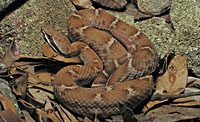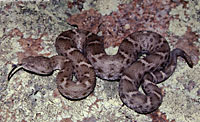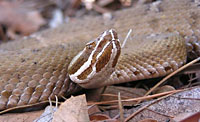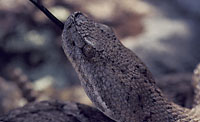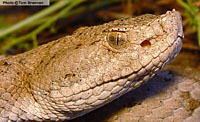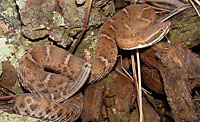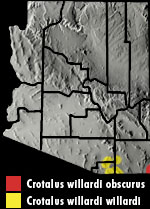Online Field Guide to The Reptiles and Amphibians of Arizona


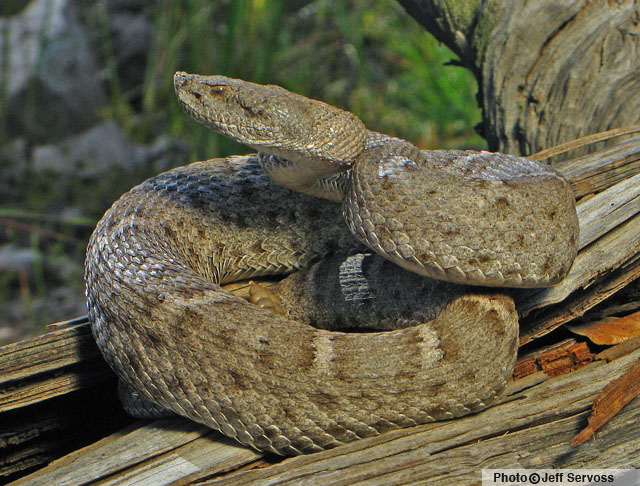
Crotalus willardi obscurus. Hidalgo County, NM
| RIDGE-NOSED RATTLESNAKE Crotalus willardi |
Venomous
|
|
DESCRIPTION: A small (up to 668 mm or 26″ in total length excluding rattle) rattlesnake. A ridge of upturned scales lining the top edge of the snout between the nostrils gives this snake its common name. There are two subspecies in Arizona: the Arizona Ridge-nosed Rattlesnake (Crotalus willardi willardi) and the New Mexico Ridge-nosed Rattlesnake (Crotalus willardi obscurus). Crotalus willardi willardi is reddish brown, orange-brown, or rust and the chin and sides of the face are marked with sharply contrasting white lines on a dark reddish brown background. Crotalus willardi obscurus does not have prominent facial markings and is is usually pale gray to gray-brown. The backs of both subspecies are marked with pale crossbars lined with darker coloration along the front and back edges. The underside is cream to white with occasional mottling of grayish to reddish brown. Young have a dark gray, black, or light yellow tail. The pupils are vertically elliptical and the dorsal scales are keeled. The neck is slender and the head is broad and triangular. On the end of the tail is a rattle composed of a series of loosely interlocking keratinous sections. In adults, a new rattle section is added each time the snake sheds its skin. DISTRIBUTION: This snake is found in many of the “sky island” mountain ranges of southeastern Arizona above 4000′ and below 9000′ elevation. Crotalus willardi willardi is known from the Huachuca, Santa Rita, Canelo, Patagonia, and Whetstone ranges. Within Arizona Crotalus willardi obscurus is found only in the Peloncillo Mountains. HABITAT: The Ridge-nosed Rattlesnake is usually encountered within Madrean Evergreen Woodland or Petran Montane Conifer Forest communities. It is often found in or near drainages with abundant canopy cover and leaf litter. BEHAVIOR: Primarily diurnal but it is occasionally crepuscular when conditions are favorable and is occasionally active into the night at lower elevations. It hibernates during the cold months of late fall and winter. This snake is primarily a ground-dweller but it sometimes climbs onto tree trunks, stumps, and the faces of rock outcroppings. Young use the dark gray or yellow colored tail to lure lizards. Like the other “pit-vipers” (members of the subfamily Crotalinae) this snake uses heat sensing pits (one on each side of the face between the eye and nostril) to detect warm-blooded predators and prey. DIET: The Ridge-nosed Rattlesnake consumes primarily lizards, mice, and centipedes but it also occasionally takes birds and scorpions. It uses venom injected through long, hollow, retractable fangs to kill and begin digesting its prey. REPRODUCTION: Mating takes place in summer. A litter of 2 to 9 young are born the following summer. SUBSPECIES FOUND IN AZ : REMARKS: This rattlesnake is capable of delivering potent venom. If encountered it should be left alone. A large percentage of envenomations occur when a snake is handled or abused. This snake is protected in Arizona. It is against Arizona State law to harass, harm, pursue, hunt, shoot, wound, kill, trap, capture, or collect Crotalus willardi or to attempt to engage in any such conduct. Crotalus willardi obscurus is listed as THREATENED under the Endangered Species Act. It is against Federal law to harass, harm, pursue, hunt, shoot, wound, kill, trap, capture, or collect Crotalus willardi obscurus or to attempt to engage in any such conduct. More information on federal listing here: http://endangered.fws.gov/wildlife.html#Species By Thomas C. Brennan Bartlett. 2000. Snakes of North America: Western Brennan, T. C., & A. T. Holycross. 2006. A Field Guide to Amphibians and Reptiles in Arizona. Arizona Game and Fish Department. Phoenix, AZ Degenhardt, W. G., Painter, C. W., and Price, A. H.. 1996. Amphibians and Reptiles of New Mexico. University of New Mexico Press. Albuquerque. Fowlie. 1965. The Snakes of Arizona. Azul Quinta Press, Fallbrook, California Lowe, Schwalbe, Johnson. 1986. The Venomous Reptiles of Arizona. Nongame Branch Stebbins. 1985. Western Reptiles and Amphibians. Houghton Mifflin. New York, NY |
|
Visit Partners in Amphibian and Reptile Conservation:


HOME
Copyright © 2023, Arizona Game and Fish Department. All rights reserved.
If you make use of the textual contents of this site in reports, publications, etc. please cite and credit the author(s) and photographer(s). All photos on this website are copyrighted. However, those found in the species account section may be used for any noncommercial scientific, educational, or conservation purposes provided that photographs are not altered and continue to bear the copyright symbol and name of the photographer. Please contact the photographer regarding commercial use of copyrighted photographs.










